Yesterday: Great Nevada Collections
Summer 2021
These collectors are cheerfully, but seriously, obsessed with relics of Nevada’s past.
By Mitch Fox and Connie Emerson
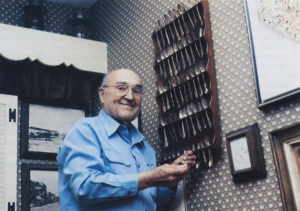
BILL WRIGHT: THE ULTIMATE NEVADA COLLECTOR
Wright, the 73-year-old king of Nevada collectors, looks up from the orange blaze in his fireplace and grins as he extolls Nevada’s historical accessibility.
“I can go to an old ghost town,” he says, “and relive the time when there were 35,000 people living there and know from research what they did for recreation, where they came from, and what they did for a living.”
Wright, who was general manager of the “Las Vegas Review-Journal“ from 1966 until 1981, moved to Las Vegas to accept a job as an advertising salesman with the paper in 1941. About 10 years later he started exploring Nevada’s wilderness areas and ghost towns while on hunting trips. Then he stumbled across some purple bottles near Ely.
“The sun had caused the manganese in these bottles to turn purple, and they’re extremely unusual and very striking,” Wright recalls. “So I brought my first purple bottle home, and everyone liked the looks of it, and so I was hooked. I started looking for ’em and started scouring Nevada’s ghost towns. I immediately fell in love with the state. When I found the first bottles, it gave me an excuse to visit all these places in the state.”
His fascination with bottles grew into a passion for other Silver State memorabilia such as gaming collectibles, trade tokens, and newspapers. He has collected about 3,000 Nevada newspapers, including one from the old ghost town of Unionville. He has assembled collections of railroad passes from 1914, commemorative plates, and silver spoons honoring Nevada towns between 1895 and 1915.
But Wright doesn’t like to flaunt his collections. He admits, “I’m not into the display aspect.” The only obvious evidence of his souvenir-mania is an inconspicuous display case with revolving trays. One shelf holds a series of glass swizzle sticks used to swirl saloon moonshine in the 1920s.
Some of his favorite finds include a matchbox holder from the Crescent Hotel in Rhyolite, a clothes brush from The Dude clothing store on Fremont Street (“Phone# 327”), and a Goldfield moustache comb made in the form of a saw in 1910.
Wright emphasizes that the chase is more important than the find.
“I have a toothpick holder from the early 1900s that Tex Rickard distributed,” says Wright with a smile. “To me it’s a challenge to go to Goldfield and see where he had his house, which is still standing.
“To get people to gamble in his gambling joint, Rickard promoted the famous Gans-Nelson fight, which was held in Goldfield in 1904. Now that’s the same thing that’s being done today by our hotels in Las Vegas. They bring all these prizefights in so people will lose all this money when they come to town. So we haven’t really gone anywhere in the last 90 years. It’s just a big circle.”
Wright predicts that gas credit cards, phone directories, hotel keys, and coffee percolators will be the relics of the future. In the meantime he’ll continue searching for an illusive trade token or stock certificate that recalls Nevada’s eccentric past.—Mitch Fox
Editor’s Note: William Wright passed away in 1998.
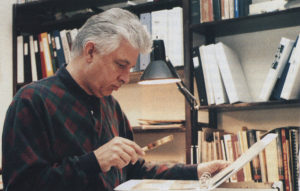
BOB STOLDAL: NEVADA POSTCARDS
As news director of KLAS-TV, the CBS affiliate in Las Vegas, Bob Stoldal leads an exciting life. He’s on a first-name basis with politicians, Strip celebrities, and the town’s movers and shakers.
But when Stoldal comes home, he loosens his tie, unbuttons his suit vest, slips into his office, and closes the door behind him. It is there, totally isolated from deadlines and live remotes, that he’ll engage· in his greatest passion: postcard collecting.
Stoldal doesn’t collect just any old postcard. It has to be a postcard about Nevada, preferably made in Nevada. He’s not sure how many thousands he’s stuffed into protective sleeves and binders, but he does need a computer to catalogue the age, photo, and message of each postcard.
The collection is awesome in size and variety. He has leather postcards, hand-tinted postcards, linen postcards from the ’30s, and “real photo cards,” in which actual photographs were printed on photographic paper and mass-distributed.
He began his hobby while writing a book about Las Vegas in the early ’20s. “I did all the statistical research, population, streets, buildings, but I didn’t have any human elements in the story,” says Stoldal, who went to high school in Las Vegas.
“Someone suggested I should start looking for old letters and maybe old postcards. Possibly I could get a feeling for what the town was like then. When I started reading the backs of these postcards, I knew I’d hit a gold mine.”
Stoldal says itinerant photographers in the early 1900s would travel from city to city and stop in such towns as Palisade, Wonder, Fay, and Rawhide. “Because of the work of these turn-ofthe-century photographers, who would shoot the boom towns and sell their prints as postcards, nearly every city in Nevada has a living, visual history,” he says.
Like a private detective Stoldal taps a variety of sources during his searches. “Dealers are a great source,” he says. “And, of course, collectors, and shows of which there are two every week in this country. You write letters, you bug your grandmother, your next-door neighbor.
“My barber’s father used to work for the Union Pacific and now lives in Utah with a box full of postcards, and every time I get a haircut I tell him to get me that box. A lot of people will give you their cards because they know you will take care of them and they know you will preserve them. This is archival material. I’m preserving these just like a library would. And hopefully I’m preserving a bit of Nevada’s past that ordinarily might be lost.” —MF
Editor’s Note: Bob Stoldal is the Chairman of the Board, Nevada Museums and History
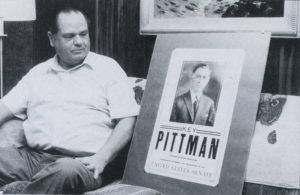
BOB ERICKSON: NEVADA DOCUMENTS
A stock certificate with a drawing of a naked woman isn’t an ordinary piece of Silver State memorabilia, but aside from its eye-catching design, do you know why this relic is considered a classic?
The naked woman is audacious’ actress Adah Isaacs Menken, strapped to the back of a horse, as she was carried up a man-made mountain to the ceiling of Virginia City’s opera house. The incident was preserved by a drawing on a 1863 stock certificate from the Mazeppa Gold and Silver Mining Company.
Las Vegas collector Bob Erickson was aware of the certificate’s history, so he quickly snatched it up after spotting it in a northern Nevada pawn shop.
Erickson, a security officer by night and Nevada document collector-dealer by day, has been scavenging pawn shops, coin shows, swap meets, and antique stores for nearly 15 years.
His fascination with historical certificates-known in collectors’ circles as “paper” -followed a lifelong interest in collectibles. “Collectors are born, not made,” he says. “I started with stamps as a little kid and eventually went into coins. I stumbled across an ad in a coin magazine advertising Nevada paper from the Comstock days. I bought one and was hooked.”
Hooked indeed. Erickson has more than a thousand documents and· 200 books on Nevada history to help him with research.
Among his prized possessions are a stock certificate with Jim Butler’s endorsement and a 1929 deed signed by J.T. McWilliams, founder of the original Las Vegas townsite. Erickson has the first check issued during Nevada’s three-year territorial period. The check is signed by Mark Twain’s brother, Orion Clemens, Nevada’s first territorial secretary.
He’s procured much of his paper from old bank vaults, brokerage houses, and coin shows, spending impressive sums of money along the way. “Certificates you could buy five years ago for $10, now you’ re got to spend $60 or $70,” bemoans Erickson. “I once paid $300 for a Virginia & Truckee bond. Now it’s only worth $150 because I found out there was quite a few of them around. That’s why it’s so important to know what you’re doing and to find out about the scarcity of an item.”
Erickson’s specialty is signatures. “I won’t be attracted to a piece of paper unless there’s a signature attached to it. It brings a human element to it. It’s not just a piece of paper.
“For example, I have Emanuel Penrod’s signature from 1859. He was Comstock’ s partner. You can run your finger over his signature and realize that this was the man who was here at the very beginning of the state. It’s kind of a thrilling thing to me.” —MF
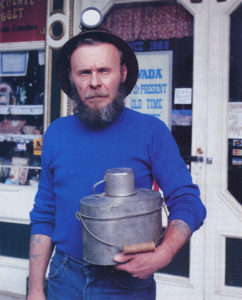
DOUG WALLING: MINER’S LUNCH PAILS
Ever since the late 1800s when the Pacific Coast Pioneers gathered together everything they could find including newspaperman Alf Doten’ s stuffed dog, Kaiser-for their museum in Virginia City, Nevadans have collected all manner of objects. Casino matchbook covers and ashtrays. Key rings. Revenue stamps. Indian artifacts. Gaming chips. Even Nevada credit cards. The list is as long as a collector’s imagination.
Take Doug Walling, for example. Although they really aren’t much to look at, he collects miners’ lunch pails.
“They’ re a very personal thing,” says Walling, who has an antique store in the Silver Dollar Hotel in Virginia City. “Whereas the picks, lanterns, and other equipment belonged to the mining companies, the lunch pails were the miners’ own possessions.”
The lunch pails, which were called dinner pails by miners who worked the last shift, were made of tin until about 1915, when aluminum began to be used commercially. Most had two or three compartments. One would hold a main course such as a meat pastie. Another would contain a tart, pastry, or other dessert while the third would hold the beverage, usually coffee. Some pails even had a cup incorporated into their design.
The lunch pails were referred to by their owners as “growlers,” according to Walling, in reference to the stomach growling when hungry. A miner’s pail also served as his identification for a free after-shift drink at one of the saloons.
The pails were smeared with lard (called “greasing the growler”) and used to transport beer to the miner’s lodging place. The lard prevented excessive foaming.
A few months ago Walling had seven pails in his collection, although he had owned others that he traded for pails in better condition. Now he has only two.
“It’s a challenge to increase the size of your collection,” Walling says, “but it’s also an opportunity to make a profit when buyers come along and want what you have.” If you searched California’s Mother Lode, you would find only two pails for sale, he says, so pails that are available bring good money. About $80 is the average price.
Like every collector, Walling has a want list. And that, he says, is why he sold all but one of the commercially made pails he had collected.
“Now I’m planning to specialize in homemade, as opposed to factory made, lunch pails,” he says. “Miners often made them out of lard pails, and a man from Tonopah told me they were so poor that their lunch pails were made from the big tomato cans.” Then he adds, “What I’d really like to find is a dinner pail full of 20 pounds of high–grade gold.” -Connie Emerson
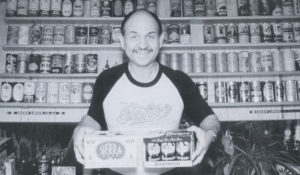
LOREN LOVE: VINTAGE BEER CANS
Loren D. Love’s letterhead says, “LOVE THOSE BEER CANS … BUY, TRADE & SELL, EMPTY-EM & DIG-EM.” You see, Love, who is park supervisor at Dayton State Park, is crazy about all kinds of breweriana—matchbooks, openers, calendars, signs, ashtrays, bottles, and cans.
Love’s beer can collection is specialized. “I only collect Northern California and Nevada pre-pull tab cans,” he says. Those Nevada cans once held beer brewed by the Reno Brewing Company, which produced Royal and Sierra beers, and the Carson Brewing Company, makers of Tahoe Beer. Carson Brewing went out of business in 1947, Reno Brewing in the mid-1950s.
Beer cans, which first appeared in the late 1930s, are of two types: the “flat top,” which was opened with a beercan opener, and the “cone top,” which was shaped like a brake fluid can with a cap on the crown.
“Though I find some of the cans in garbage dumps, cans weren’t designed to be saved,” Love says, “so the bulk of mine are ‘indoor cans’ found in attics, basements, and walls of buildings.” Many of those cans are well worth finding. Royal Beer cans, for example, bring up to $100 apiece.
Trading is one of the best ways for beer can fanciers to upgrade their collections, according to Love. For that purpose, each year he holds a Beer Can Collectors Swap Meet at Dayton State Park.
Love’s favorite is a 1937 Tahoe Beer can. He says, “The lithography on some of those early cans is a work of art.”—CE
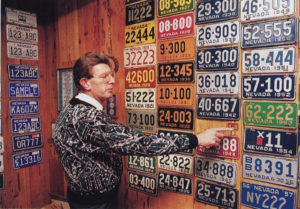
JOHN MILLER: NEVADA LICENSE PLATES
Newspaperman John Miller thinks his collectibles-license plates-are works of art, too. In fact, one wall in the family room of the Millers’ Carson City home is decorated with them. About 200 of the plates in his collection are from Nevada and date back to 1916, the first year that license plates were issued by the state.
Miller got started collecting as a youngster when he found a few plates in a shed on the family ranch in Fallon and promptly nailed them to the barn wall. Through the years, he found more plates, was given them by friends and relatives, traded, bought. Now he has several hundred.
Miller says that an added bonus of license-plate collecting is that, unlike many collectibles, the plates have a date and point of origin stamped right on them.
“With a little research, I can find out what town the license plate came from, who owned it, and what kind of a vehicle it was on.”
Of all the Nevada plates in his collection, the toughest to obtain was one from 1917. Miller finally found it in a Genoa antique store. The prettiest, he maintains, is from 1958. Its background is powder blue and the letters are silver.—CE
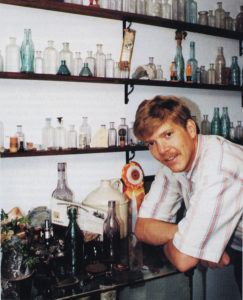
FRED HOLABIRD: A MILLION PIECES OF THE PAST
From the time he arrived in Nevada in the early 1870s, the state’s foremost early-day collector, Dr. Simeon Lemuel Lee of Carson City, collected everything from coins and ceramics to minerals and Indian baskets.
Lee’s present-day northern counterpart is mining executive-geologist Fred Holabird of Reno, who has between 10,000 and 20,000 items in his private collection and “about a million pieces of Nevadiana” in the inventory of his company, Columbus Industries, which has grown as an offshoot of his passion for collecting.
“Many of my collections are related to work activities,” Ho la bird says. “A mining project in the Bullfrog District, for example, will get me started collecting artifacts from that area. One in Pioche, and I’m collecting artifacts from there.
“What I look for are articles that seem neat to me-like the mining stock certificate from the Fly by Night Mining Company or the 1904 presentation pin from the Tonopah Railroad or the ticket for a foot race in Virginia City on December 24, 1904.”
Although he has large collections of mining memorabilia, between 150 and 200 ghost-town trade tokens, and thousands of documents and other items, Holabird says his “most serious collection” is of Nevada merchant name bottles.
These embossed bottles, which have raised lettering and designs, contained liquor, medicine, or soda pop. Some bear the names of ghost-town merchants; others advertise early businesses in Virginia City, Eureka, Tonopah, and Reno. Holabird’s bottle collection, which has been described as the finest in the state, is only two bottles short of being complete.
While Nevada bottles can range in value from 10 cents to more than $2,000, and other rare Nevadiana brings many thousands of dollars, Holabird maintains that most collectors aren’t primarily involved in collecting for financial gain.
“There is no doubt whatsoever that most people collect for the love of it,” he says. “But investment does provide a strong secondary market.”
Whether or not they make a lot of money by gathering pieces of the past, most Nevada collectors would agree that their hobbies have given them pleasure that money can’t buy.—CE
COLLECTING NEVADIANA
Surprisingly, Nevada memorabilia is even more popular with out-of-state collectors than Nevadans, according to Reno’s Fred Holabird. The best Western memorabilia has made its way to Europe, he says, since Americans often can’t afford the high prices the items command.
Dealers say that during the last two or three years Nevada gaming chips and trade tokens have come into their own as collectibles. Three reasons chip collecting has become popular, according to George R. Squires, owner of Reno Coin Company, is that chips are “colorful, historical, and fun.”
Then, too, collecting chips and tokens is affordable. Whereas a trade token can sell for hundreds or in a few cases thousands of dollars, most of them are in the $5 to $100 range. Gaming chips are less expensive, with the majority costing between $3 and $20.
Nevada postcards are also affordable collectors’ items. The cards’ rarity and condition affect their value, of course. Cards made by the J .A. Mitchell Company (one of the big pre-World War I postcard manufacturers) sell for $3 to $9 but can go higher. A postcard of Wonder, Nevada, brought a dealer $25.
Other Nevada mementos spotted in antique stores around the state include tickets from railroads that no longer exist, such as the Nevada Central and Eureka Palisade; Virginia City newspapers from the 1880s (the going price is about $10); county fair ribbons, key rings with Nevada business logos; and metal drink trays advertising beverages made in the Silver State. Prices are generally negotiable, so don’t be afraid to haggle if you decide to start collecting pieces of Nevada’s past.—CE
MEMORABLE MEMORABILIA
While most Nevada collections are kept in private homes around the state, others are on public display. Following is a statewide sampling of public Nevadiana, from south to north. For further information, see the museum listings in Nevada Events.
BOULDER CITY
Boulder City/Hoover Dam Museum: Has a nice collection of photographs of the construction of Hoover Darn.
HENDERSON
Clark County Heritage Museum: Among its collections is a group of old buildings moved to the site, including houses from early Las Vegas, Boulder City, and Henderson. A new exhibit building was opened recently.
LAS VEGAS
Imperial Palace Auto Collection: Two cars with Nevada connections are Death Valley Scotty’s 1905 National and a 1954 Chrysler New Yorker Deluxe that belonged to Howard Hughes, who drove it when he was in town.
Liberace Museum: The clothes, pianos, and candelabra that Liberace made famous are collected in this mecca for the late entertainer’s fans.
Nevada State Museum and Historical Society: Frequent exhibits on Nevada subjects.
Rio Suite Hotel: A dozen antique slot machines, some exquisitely detailed, are placed alongside a recreated marble street of Rio de Janeiro.
OVERTON
Lost City Museum: Collections of artifacts left by ancient Basketmrnaker and Pueblo people who lived in the Moapa Valley.
PIOCHE
Lincoln County Museum: Clothing, minerals, and bottles from the early days in Panaca, Pioche, and Caliente.
TONOPAH
Central Nevada Museum: Mining artifacts, extensive research materials and photo file, and memorabilia from the Tonopah Army Air Field (1941-45) are among the top exhibits.
HAWTHORNE
Mineral County Museum: An eclectic collection with fossils from Stewart Valley, a jail cell from Rawhide, and an anchor used by a ferry that used to cross Walker Lake.
FALLON
Churchill County Museum: Numerous collections include carriages and other old-time vehicles, early-day furnishings, telephones, photographs, and a remarkable display of corkscrews.
YERINGTON
Lyon County Museum: Memorabilia on local ranching history.
CARSON CITY
Nevada State Archives: Holds territorial records dating back to 1851 and state documents back to 1864; available for research.
Nevada State Museum: Collections of baskets by Washoe weaver Oat So La Lee, silver dollars and other coins made at Carson’s old U.S. Mint in the 1800s, and many others.
Nevada State Railroad Museum: The Inyo and Dayton locomotives of the historic Virginia & Truckee Railroad, the old depot moved from Wabuska, and time tables, photos, and other Nevada railroad artifacts.
Stewart Indian Museum: Highlights include collections of basketry and artifacts of the Paiute, Washoe, and Shoshone peoples.
RENO
Harolds Club: Pure nostalgia, from Pappy Smith’s 1949 Buick woody covered with tooled leather and silver dollars to the collection of Jim BeamHarolds Club decanters in the Roaring Camp Bar.
William F. Harrah Foundation National Automobile Museum: Nevada cars include Bill Harrah’s own Jerrari (combining a Jeep Wagoneer with a Ferrari) and a 1936 Cord Westchester Sedan (manufacturer E.L. Cord was a prominent Reno resident in the years prior to his death).
Liberty Belle Restaurant and Saloon: Owners Marshall and Frank Fey present more than 50 vintage slot machines, including several art-deco beauties from the 1930s, a Frank Polk carved cowboy, and several antique machines. Star of the show is the Liberty Bell, the first slot machine, which was invented by the Feys’ grandfather.
Wilbur D. May Museum: Late world-traveler’s personal collections are presented in a recreation of his Double Diamond Ranch home.
Mackay School of Mines Minerals Museum: This museum on the UNR campus has a vast collection of mineral specimens from mining areas around the state.
Nevada Masonic Grand Lodge Library and Museum: The DeWitt Clinton Commandery No. 1 uniform decorated with Comstock silver thread, and contents of cornerstones from the old lodge buildings at Virginia City and Gold Hill. Museum is on third floor at 40 West First Street.
Nevada Historical Society Museum: Don’t miss the collections of Indian artifacts and Victoriana.
SPARKS
John Ascuaga’s Nugget: The Fred M. Anderson, M.D., Collection of Banding Irons is on the second floor.
Sparks Heritage Foundation Museum: Railroad memorabilia includes one of the most extensive collections of railroad lanterns in the West.
Sierra Sid’s: Gun collection includes a Nevada “Battle Born” combo .22/.45 and a handgun commemorating the Nevada Centennial.
VIRGINIA CITY
Bucket of Blood Saloon: Displayed are 23 antique pickle casters that once sat on the tables of Virginia City’s finer residences. Don’t miss the intricately worked silver forks attached to each.
Comstock Firemen’s Museum: Firefighters’ memorabilia including hose carts and old-time helmets.
Fourth Ward School Museum: Desks, books, and atmosphere from Victorian school used from 1876 to 1936.
Nevada Gambling Museum: Extensive collection of cards, dice, gambling tables, unique games, all well presented.
Others include the Mark Twain Museum, Julia C. Bulette Red Light Museum, Mackay Mansion, Museum of Memories, The Castle, The Way It Was Museum, and Wild West Museum.
LOVELOCK
Marzen House Museum: Old ranching equipment and other area relics.
WINNEMUCCA
Humboldt Museum: Memorabilia that belonged to local girl Edna Purviance, leading lady in numerous Charlie Chaplin films.
ELKO
Northeastern Nevada Museum: Collections include Basque clothing and ceremonial artifacts, and Elko saddlemaker G.S. Garcia’s beautiful silver work and saddles.
EUREKA
Eureka Sentinel Museum: Old newspaper offices with equipment.
ELY
Nevada Northern Railway Museum: Eighty pieces of museum-quality rolling stock are part of this facility, which operates as a tourist railroad.
White Pine Public Museum: A high point is the Eugene Stoddard Geology Display with its extensive collection of Nevada minerals. Another is the huge doll collection left by the late Mary Frances Hesselgesser.

